What Do Marine Iguanas Feed on


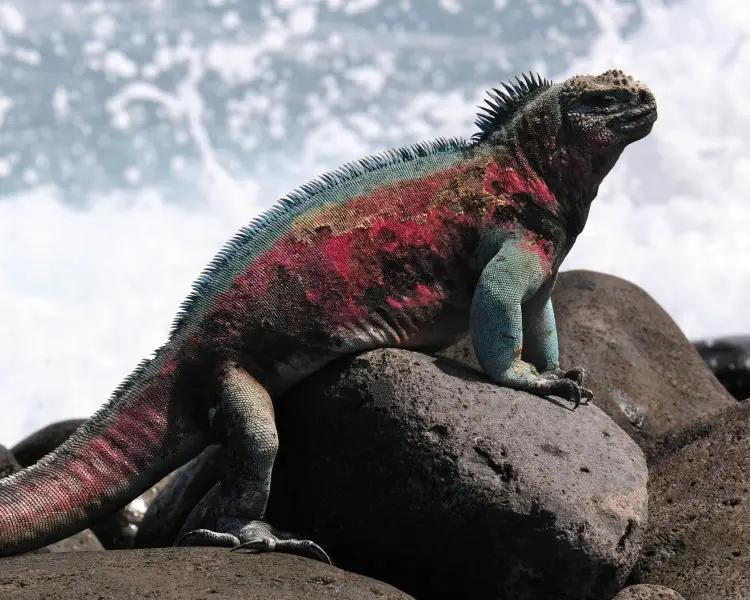
Marine Iguana
Galápagos marine iguana, Galapagos Marine iguana, Fernandina Marine iguana, Sea iguana, Marine iguana
Marine iguanas are the only sea-going lizards in the world. They are usually black or gray but during the breeding period adult males gain green and red coloration. The dark skin pigment helps in shielding the animals from ultraviolet rays and also helps to warm their bodies. Young iguanas have a dorsal stripe of a lighter color. Their dorsal scales are a triangular shape and they have a long tail which propels them through water when swimming. They are often encrusted with a white substance, which mainly consists of excess salt excreted via their nasal glands.
Photos with Marine Iguana
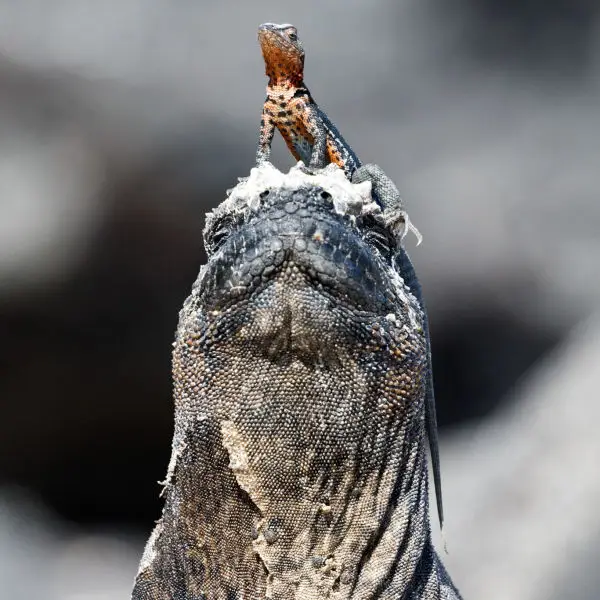

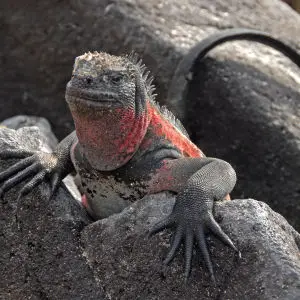
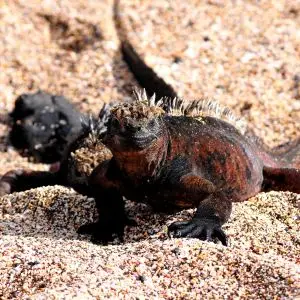
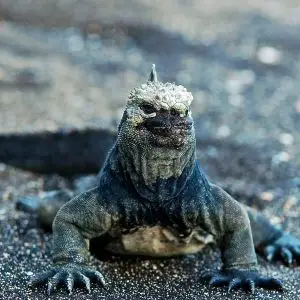
View 41 more photos of Marine Iguana
Video
Distribution
Geography
The marine iguana lives in the Galapagos Islands, an archipelago near the South American coast. Many of these islands have intertidal flats, steep rock cliffs, and low rock ledges. The marine iguana requires access to the sea and a sandy area in which to lay eggs.

Biome
Climate zones
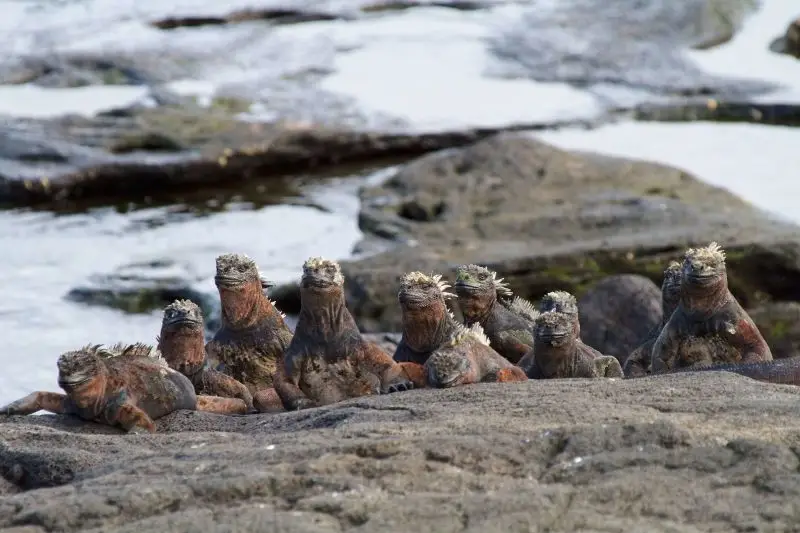
Habits and Lifestyle
Marine iguanas are diurnal. When not hunting in the sea for food, they bask on rocks, often several thousand individuals together in the same area. They live in colonies. Before it can feed, the marine iguana must increase its body temperature to approximately 36°C. Its temperature can drop as much as 10°C when it is in the ocean. In order to regulate its body temperature, an iguana must spend long periods of time basking in the sun. With a low body temperature it will move more sluggishly, and so is then at greater risk from predators. To combat this vulnerability, the iguana acts in a highly aggressive way to bluff its way out of danger.
Diet and Nutrition
Marine iguanas mostly eat marine algae. Larger iguanas will dive into the sea in order to forage, sometimes diving as deep as 12 m (39 ft) and staying submerged for more than an hour. Under normal circumstances they make shallow dives, usually lasting around 10 minutes. The smaller iguanas keep out of the water, feeding instead on algae on rocks in the tidal area.
Mating Habits
Marine iguanas are polygamous. Males fight aggressively to secure a mate, females selecting them based on their body size, preferring larger individuals. Females are sexually mature at 3 to 5 years, and males at 6 to 8 years. The breeding season is from December to March and the nesting season from January to April. Females go inland to lay 1 to 6 eggs in a burrow of sand, along with thousands of others nesting in the same area, due to suitable sites being scarce. They will defend their burrow for a few days before leaving the eggs to incubate, which takes 89 to 120 days. Upon hatching, the baby iguanas dig themselves out from their nest and move down to the intertidal zone, where they start feeding.
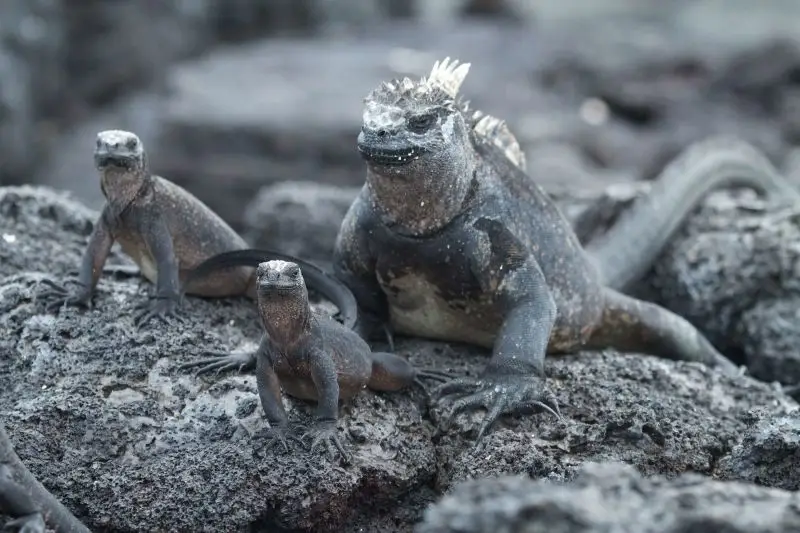
Population
Population threats
Potential predators include the Galapagos hawk, lava heron, great blue heron, striated heron, short-eared owl and frigate bird. They are also threatened by climate change, and marine pollution including oil spills, which could destroy the algae they eat, as well as their habitat.
Population number
According to Wikipedia resource, the International Union of Conservation of Nature estimates that at least 50,000 Marine iguanas exist, while estimates from the Charles Darwin Research Station are in the hundreds of thousands. Overall, currently Marine iguanas are classified as Vulnerable (VU) on the IUCN Red List.
Fun Facts for Kids
- Marine iguana is one of the few strictly vegetarian lizards in the world. It mainly eat seaweed.
- The saw like ridge of spines on the iguana's back not only given a sinister appearance but also helps regulate its body temperature as the iguana basks in the sun
- Marine iguanas sneeze. They do this because when eating, they swallow saltwater, and once back on land they have to get rid of the salt. Their salt-excreting glands help them do this, and, as they sneeze, the saltwater comes out.
- Marine iguanas have a good relationship with mockingbirds because when Galapagos hawks are hunting, mockingbirds sound their distinctive cry, which some iguanas have learned means danger, and so they run for cover.
- Some marine iguanas grow very large because of the abundance of food in their environment. If there is a plentiful supply of underwater algae, this means they can grow much bigger than those iguanas living where there is less food. Whichever island they live on, being the biggest animal is what they strive for. The females prefer the biggest males, and the best eggs are laid by the biggest females.
- An adult iguana is able to stay under water for as long as 45 minutes.
- An iguana can grow another tail if it is cut off. Often they will break off their own tail to escape a predator when they have been caught.
- Iguanas are able to stop their heart from beating for as long as one minute.
References
More Fascinating Animals to Learn About
Source: https://animalia.bio/marine-iguana